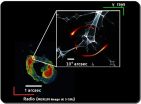A black hole under the gravitational lens
An unusual observation method uncovers processes near the event horizon of a distant, massive monster
2015-07-08
(Press-News.org) This news release is available in German.
Turbulent processes take place close to supermassive black holes, which lurk in the centres of nearly all galaxies. They swallow up matter flowing in from the outside while at the same time producing so-called gas jets which shoot out into space in two opposite directions. Researchers at the Max Planck Institute for Physics in Munich and the University of Geneva have now succeeded in localizing the origin of the high-energy gamma radiation in such a jet: it apparently originates very close to the black hole. This discovery was made possible by a micro-gravitational lens effect that occurs by chance and selectively amplifies the light from different regions close to the black hole like a magnifying glass.
Astronomers are aware of many active galaxies which emanate such jets from their centre. These gas jets can be seen in the radio region, and occasionally in visible light and in the X-ray and gamma radiation regions as well. There is still a great deal of uncertainty about the mechanism of their formation. What is clear is that hot gas in the form of a disk orbits the central black hole. It is probable that strong magnetic fields, which accelerate the particles at right angles to the disk and into the jets, occur here as well.
This central machinery cannot, however, be observed directly from Earth due to the large distances involved. A stroke of luck helped Ievgen Vovk from the Max Planck Institute of Physics and his colleagues in Geneva here. The researchers looked at an active galaxy known as PKS 1830-211. This is a blazar - a rare case in which one of the two jets happens to be directed towards Earth so that the astronomers look directly into the jet along the longitudinal axis.
It so happens that there is a galaxy roughly half way between Earth and the blazar, which is billions of light years away. Its strong gravitation causes the space around it to curve. The light of the blazar behind it passes through this space well and takes a detour - as if it were passing through a lens. PKS 1830-211 thus appears in the sky as two images; and these images are brighter than the blazar would be without this lens effect.
Astronomers had already recorded intensity flare ups in the radio region which originated from events in the blazar. Since the light propagation paths of the two images are different in length, they do not light up simultaneously after a flare up, but around 26 days apart. Vovk and his colleagues have now scoured the data from the Large Area Telescope on board the Fermi space telescope looking for such flare ups in the gamma ray region.
The resolution of the telescope here is not sufficient to be able to image the two pictures separately, but the astronomers also found flare ups which occurred periodically with an almost constant delay. "The period was approximately as long as that in the radio region, but the amplification factors of the intensity were much larger and more variable," says Ievgen Vovk.
This behaviour and further findings from observations can be best explained with an interesting assumption: Although the brightness variations in the gamma ray region also originate from the flare ups in the blazar, they are amplified to different degrees by the gravitational lens effect of individual stars in the foreground galaxy. This always occurs when a star happens to pass in front of the gamma ray emitting part of the blazar as seen from Earth.
The splitting of the images produced here is so small as to be unobservable. "It would correspond to the size of an ant on the Moon," says Vovk. Astrophysicists call this a micro-gravitational lens effect. However, the intensity amplification of the images by factors of two to seven is much greater than in the radio region. The stars thus briefly highlight the gamma ray region, as it were, as if through a magnifying glass.
All findings can be best explained in the context of the micro-gravitational lens effect with a very compact gamma ray region which extends over several ten billion kilometres. This corresponds roughly to the diameter of our solar system or to that of a black hole with a mass of one billion solar masses.
"According to our findings, the gamma ray region is only slightly larger than the black hole itself," says Andrii Neronov from the University of Geneva. Since the jet originating from the centre widens with increasing distance, the gamma radiation is probably being generated very close to the black hole, i.e. quasi at the foot of the jet.
How this radiation is generated is still not known. According to the most prevalent theory, the black hole and the gas disk are surrounded by a strong magnetic field in which particles such as electrons are accelerated to almost the speed of light. These can collide with light particles (photons), transferring so much energy to the particles in the process that they become gamma or X-ray photons.
INFORMATION:
Original publication:
A. Neronov, I. Vovk, D. Malyshev
Central engine of a gamma-ray blazar resolved through the "magnifying glass" of gravitational microlensing
Nature Physics, online 6 July 2015
[Attachments] See images for this press release:

ELSE PRESS RELEASES FROM THIS DATE:
2015-07-08
New findings about the mechanisms involved - or not involved - in the effects of the most common form of bariatric surgery suggest that combining surgery with a specific type of medication could augment the benefits of the procedure. In a report that has been published online in the journal Endocrinology, Massachusetts General Hospital (MGH) investigators report that the effects of Roux-en-Y gastric bypass (RYGB) do not utilize neurologic pathways controlled by the serotonin 2C receptor. Since that receptor is a proven target for the FDA-approved anti-obesity drug lorcaserin, ...
2015-07-08
SPOKANE, Wash.--Washington State University researchers have found that people can manage chronic pain and reduce their reliance on opioids through an Internet-based program that teaches non-medical alternatives like increased physical activity, thinking more positively and dealing with emotions.
Marian Wilson, an assistant professor in the College of Nursing, tracked 43 people with chronic non-cancer pain as they went through an eight-week course of online tools to manage psychological, social and health issues associated with chronic pain. Compared to a similar-sized ...
2015-07-08
Researchers have developed a way to help ecosystems bounce back after human disturbances such as shipping, oil exploration or fishing, and have applied it to a coral reef fish species.
The method helps conservation managers create a cost-effective plan to bring species back from the brink of extinction in a local area, by building connections with the same species in nearby locations.
"The world is subject to nasty surprises, and this work for the first time shows how to promote faster species recovery following such a surprise," said Professor Quentin Grafton from ...
2015-07-08
In the life of almost every household appliance, there comes that moment of out with the old and in with the new.
However, while electrical and electronic equipment have never been more efficient, economical or in demand, consumers' desire to own the best and the latest is contributing to an environmental issue of increasing seriousness and concern.
"E-waste is one of the fastest growing waste streams in developing, emerging and developed regions and it covers all electrical and electronic equipment and parts discarded by consumers," says Dr Sunil Herat, Associate Editor ...
2015-07-08
Nanowires are wired-shaped materials with diameters that are tens of nanometers or less. There are many types of nanowires, including semiconducting composite nanowires, metal oxide composite nanowires, and organic polymer nanowires, and they are typically used in functional materials and devices used as sensors, transistors, semiconductors, photonics devices, and solar cells.
Molecular wires composed of only inorganic materials have attracted significant attention due to their stable structures, tunable chemical compositions, and tunable properties. However, there have ...
2015-07-08
The research team led by Dr. Jongsoo Jurng and Dr. Gwi-Nam at KIST stated that, "In cooperation with KT&G, KIST has developed a nano-catalyst filter coated with a manganese oxide-based nano-catalyst, which can be used in a smoking room to reduce and purify major harmful substances of cigarette smoke. the KIST-developed catalyst removes 100% of the particle substances of cigarette smoke, such as nicotine and tar, converting those into water vapor and carbon dioxide. According to the research team, the air cleaning equipment based on the newly-developed catalyst can purify ...
2015-07-08
Heavy rainfall events setting ever new records have been increasing strikingly in the past thirty years. While before 1980, multi-decadal fluctuations in extreme rainfall events are explained by natural variability, a team of scientists of the Potsdam Institute for Climate Impact Research detected a clear upward trend in the past few decades towards more unprecedented daily rainfall events.
They find the worldwide increase to be consistent with rising global temperatures which are caused by greenhouse-gas emissions from burning fossil fuels. Short-term torrential rains ...
2015-07-08
Male badgers that spend their youth fighting tend to age more quickly than their passive counterparts according to new research from the University of Exeter.
The 35-year study revealed that male badgers living alongside a high density of other males grow old more quickly than those living with lower densities of males.
The results, which are published in the Proceedings of the Royal Society B, indicate that competition between males in early life accelerates ageing in later life, providing a potential explanation for why males age faster than females.
Author Christopher ...
2015-07-08
A review in The Obstetrician & Gynaecologist (TOG) finds that reducing the risk of stillbirth calls for better monitoring of women during their pregnancy to help find those whose babies' lives could be saved by early delivery.
In the UK the absolute risk of stillbirth is low, affecting approximately 4 in 1000 babies (MBRRACE). Although for most cases the exact cause of death is unclear, stillbirth is associated with complications during childbirth, maternal infections during pregnancy, maternal health conditions such as high blood pressure or diabetes, foetal growth restriction ...
2015-07-07
Several recent U.S. health policies, including the Affordable Care Act, provide incentives for transforming the delivery of health care to improve its value for dollar. Michael K. Gusmano, a Hastings Center scholar, and Frank J. Thompson, a distinguished professor at Rutgers University, critically examine efforts to shape the delivery of Medicaid through demonstration projects called Delivery System Reform Incentive Payment Initiatives (DSRIP). Despite political enthusiasm for DSRIP, they conclude in an article in Health Affairs that the evidence supporting its effectiveness ...
LAST 30 PRESS RELEASES:
[Press-News.org] A black hole under the gravitational lens
An unusual observation method uncovers processes near the event horizon of a distant, massive monster




